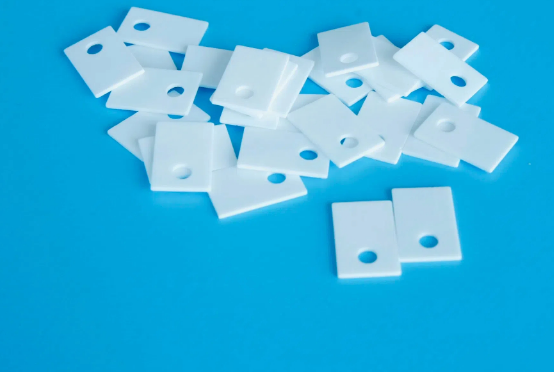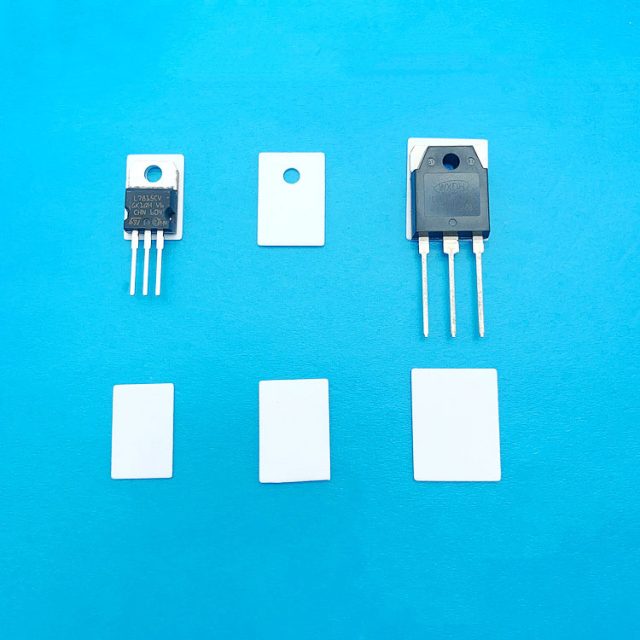With the development of electronic equipment, the power is higher and higher, the size is smaller and smaller, and the requirement of thermal conductivity is more and more strict. The previous insulation materials can not meet the needs of equipment. Alumina ceramic is a kind of material with high thermal conductivity and insulation, which can replace the previous thermal insulation materials.

1. Heat path
When a ceramic substrate is used as a thermal conductive material, it is also necessary to coat the two surfaces with thermal conductive silicone grease to fill the small gap between the ceramic gasket and the heat sink, and between the ceramic gasket and the power device, thus the contact thermal resistance is reduced.
The thermal resistance of power devices to ambient temperature is mainly composed of thermal resistance of silicon grease, thermal resistance of alumina ceramic chip, thermal resistance of silicon grease and thermal resistance of heat sink. Its cooling path is divided into two parts:
1) power unit (heat source)→ thermal conductive silicone resin → ceramic gasket → thermal conductive silicone resin → heat sink (mainly for heat transfer) ;
2)→ heat sink of ambient air (mainly through convection heat transfer) .
The main factors affecting the thermal resistance of power devices include the surface smoothness of ceramic gasket, the thickness of ceramic gasket and thermal conductive silicone, the thickness and shape of heat sink, the pressure of fastener, etc. . These factors are also related to the actual application conditions, so the thermal resistance between the power device and the heat sink will also depend on the actual assembly conditions.
Fig. 1 a thermal resistance model of a power device with an alumina ceramic pad.

2. Installation process and cooling design
1) heat sink type: compared with the heat conduction gasket, the ceramic gasket has the following defects (the key points to pay attention to when selecting the heat sink) : the material of the alumina ceramic heat conduction gasket is hard but fragile, and its bending and deformation resistance is poor. In the case of very poor surface flatness of the heat sink, they are prone to breakage during installation. Therefore, when ceramic gaskets are used as heat conducting elements, it is necessary to require manufacturers to control the surface flatness of heat sinks to ensure that the index is within the allowable range.
2) process assembly method (taking power MOS tube as an example to analyze) . Ceramic Gasket, power MOS tube and heat sink involve process and safety problems in the process of installation.
A) screw fixation method. Due to the limited creepage distance between the screw and the metal part of the power MOS tube after installing the power MOS tube, the screw fixing mode can only be used in the occasion of functional insulation (the heat sink is not grounded by the shell) , and can not be used in the occasion of strengthening the insulation (the shell is used as the heat sink, and the safety distance requirement is large) , otherwise it can not meet the safety requirement.
B) the power MOS transistor in TO-247 package is fixed with screws. The back of the TO-247 package power MOS tube radiates only metal and the rest is plastic. Therefore, no special treatment is required for fixed-power MOS transistors. Instead, the ceramic gasket (both sides coated with heat-conducting silicone) is clamped between the power MOS tube and the heat sink and secured directly with screws to meet functional insulation requirements, as shown in figures 2(a) and (b) . The creepage distance between the metal part of the power MOS transistor and the screw is 1.3 mm to 1.5 mm (depending on the shape of the power MOS transistor provided by the manufacturer) .
Fig. 2(a) rear view of a power MOS transistor encapsulated in TO-247; (B) a power MOS transistor encapsulated in To-247 is bolted.
The Alumina ceramic heat sink is used as the thermal conductive material between the power device and the heat sink, which has the advantages of high thermal conductivity, high temperature/high pressure resistance, uniform heating, fast heat dissipation and simple and compact structure, it has a broad application prospect in high-power power supply products.
